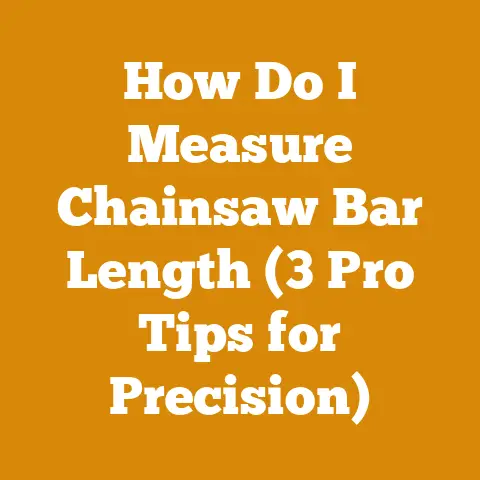Weld On Log Splitter Wedge Guide (DIY Tips for Pro-Level Woodwork)
Do you ever find yourself staring at a massive log, feeling a mix of excitement and dread?
The excitement of turning it into usable firewood, beautiful lumber, or a unique woodworking project, but the dread of the sheer effort and potential cost involved?
I know that feeling well.
Over the years, I’ve learned that success in wood processing, whether you’re splitting firewood for winter or crafting intricate furniture, hinges on two things: skill and smart budgeting.
Today, we’re diving deep into a specific area that can significantly impact both: welding a log splitter wedge guide.
We’ll explore the DIY process, the costs involved, and how it can elevate your woodworking game to a “pro-level,” all while keeping your wallet happy.
Weld On Log Splitter Wedge Guide (DIY Tips for Pro-Level Woodwork)
Improving your log splitter with a welded wedge guide can dramatically enhance its performance and your efficiency.
This modification helps stabilize the log, leading to cleaner, safer splits, especially with knotty or uneven pieces.
But what does it cost, and is it worth the effort?
Let’s break it down.
Why Even Bother with a Wedge Guide?
Before we get into the nitty-gritty of costs, let’s understand why a wedge guide is beneficial.
I remember the first time I tackled a massive oak log with my basic splitter.
The log twisted, nearly popped off, and sent a shiver down my spine.
That’s when I realized the limitations of my setup.
- Enhanced Safety: A wedge guide keeps the log aligned, reducing the risk of it shooting off to the side.
- Improved Efficiency: Cleaner splits mean fewer re-splits, saving you time and energy.
- Greater Control: Especially useful for oddly shaped or knotty logs.
- Extended Splitter Life: Reduced stress on the splitter ram and components.
The DIY Approach: A Cost-Conscious Choice
Opting for a DIY weld-on wedge guide is a smart move if you have basic welding skills and access to equipment.
It’s significantly cheaper than buying a pre-fabricated unit, and you can customize it to your specific splitter and needs.
Understanding the Cost Breakdown
Now, let’s dissect the costs involved in this DIY project.
Remember, these are estimates, and your actual expenses may vary based on your location, the materials you choose, and any existing resources you have.
Material Costs: The Foundation of Your Project
The type and amount of steel you use will significantly affect the price.
Steel Selection and Pricing
- Mild Steel: This is the most common and affordable option.
Look for rectangular or square steel tubing or flat steel stock.- Cost: Expect to pay around $1-$3 per pound.
A typical wedge guide might require 10-20 pounds of steel, translating to $10-$60. - Data Point: According to a recent report by SteelBenchmarker, mild steel prices have fluctuated significantly in the past year due to global supply chain issues.
Keep an eye on market trends to snag the best deals.
- Cost: Expect to pay around $1-$3 per pound.
- High-Strength Steel: Offers greater durability and resistance to bending, but comes at a premium.
- Cost: $3-$6 per pound.
- Salvaged Steel: Consider repurposing steel from old bed frames, scrap metal yards, or other sources.
This can significantly reduce costs, but ensure the steel is of adequate thickness and quality.- Cost: Potentially free or very low cost, but requires more effort to source and prepare.
Welding Supplies
- Welding Wire/Rods: The type you need depends on your welding machine and the type of steel you’re using.
- Cost: A spool of welding wire (e.g., MIG wire) can range from $20-$50.
Welding rods (e.g., stick welding) are typically cheaper, around $10-$30 for a small pack.
- Cost: A spool of welding wire (e.g., MIG wire) can range from $20-$50.
- Shielding Gas (for MIG Welding): If you’re using a MIG welder, you’ll need shielding gas (usually a mix of argon and CO2).
- Cost: A small cylinder can cost $50-$100 to purchase or rent.
Refills typically range from $20-$50.
- Cost: A small cylinder can cost $50-$100 to purchase or rent.
- Cutting Discs/Grinding Wheels: Essential for cutting and shaping the steel.
- Cost: $5-$15 per disc/wheel.
You’ll likely need a few.
- Cost: $5-$15 per disc/wheel.
Fasteners and Hardware
- Bolts/Nuts: For attaching the wedge guide to the splitter frame.
- Cost: $5-$20, depending on the size and quantity.
- Primer/Paint: To protect the steel from rust and corrosion.
- Cost: $10-$30 per can.
Labor Costs: Your Time is Valuable
If you’re doing the welding yourself, the primary labor cost is your time.
However, if you’re hiring a professional welder, this will be a significant expense.
DIY Labor: Estimating Your Time
- Design and Planning: 2-4 hours.
- Material Sourcing: 1-2 hours.
- Cutting and Shaping: 2-4 hours.
- Welding: 3-6 hours.
- Finishing (grinding, painting): 1-2 hours.
- Total Estimated Time: 9-19 hours.
Let’s say you value your time at $20 per hour (a reasonable rate for skilled labor).
That translates to a labor cost of $180-$380.
This is a hidden cost that many DIYers overlook.
Professional Welding: The Alternative
Hiring a professional welder will save you time and ensure a strong, safe weld.
However, it comes at a cost.
- Hourly Rate: Professional welders typically charge $50-$100 per hour.
- Project Estimate: A simple wedge guide welding job might take 2-4 hours, translating to a cost of $100-$400.
Data Point: According to the American Welding Society, the demand for skilled welders is increasing, leading to higher labor rates in some regions.
Tool Costs: Existing Arsenal or New Investments?
Consider the tools you already have and what you might need to purchase or rent.
Essential Tools
- Welding Machine: MIG, stick, or TIG welder.
- Cost: If you don’t own one, renting a welder can cost $50-$100 per day.
Purchasing a basic MIG welder can range from $300-$800.
- Cost: If you don’t own one, renting a welder can cost $50-$100 per day.
- Angle Grinder: For cutting, shaping, and grinding steel.
- Cost: $50-$150.
- Welding Helmet: Essential for eye protection.
- Cost: $50-$200.
- Welding Gloves: For hand protection.
- Cost: $20-$50.
- Measuring Tools (tape measure, square): For accurate measurements.
- Cost: $10-$30.
- Clamps: To hold the steel in place while welding.
- Cost: $20-$50 for a set.
Optional Tools
- Plasma Cutter: For cleaner and faster steel cutting.
- Cost: $300-$1000.
- Drill Press: For drilling precise holes.
- Cost: $100-$500.
Hidden Costs: Don’t Get Caught Off Guard
- Electricity: Welding consumes a significant amount of electricity.
Factor in the cost of increased power usage. - Consumables: Welding wire, grinding discs, and other consumables will need to be replaced periodically.
- Mistakes: We all make mistakes. Factor in the cost of potential errors and rework.
- Permits: In some areas, you might need a permit for welding projects.
Check your local regulations.
Cost Summary: Putting it All Together
Let’s create a cost summary table based on the information above.
Analysis: As you can see, the DIY approach can be significantly cheaper, especially if you already own the necessary tools.
However, if you value your time highly or lack welding skills, hiring a professional might be a more cost-effective option in the long run.
Tips for Cost Optimization
Here are some practical tips to help you minimize the costs of your DIY weld-on wedge guide project:
- Shop Around for Steel: Compare prices from different suppliers, including scrap metal yards and online retailers.
- Use Salvaged Steel: Repurposing steel can save you a significant amount of money.
- Buy Welding Supplies in Bulk: If you plan on doing more welding projects, buying supplies in bulk can be more economical.
- Rent Tools Instead of Buying: If you only need a tool for this project, consider renting it instead of buying it.
- Plan Carefully: A well-thought-out plan can prevent mistakes and wasted materials.
- Practice Your Welding: Before welding the final pieces, practice on scrap metal to improve your skills and avoid errors.
- Barter with a Welder: If you have skills or resources that a welder might need, consider bartering for their services.
- Look for Free Resources: Online forums, YouTube tutorials, and local maker spaces can offer valuable tips and guidance.
The Pro-Level Woodwork Advantage
While the cost savings are attractive, the real value of a wedge guide lies in its ability to elevate your woodworking and firewood processing to a professional level.
- Consistent Splits: Cleaner, more consistent splits are essential for firewood that burns efficiently and for woodworking projects that require precise dimensions.
- Reduced Waste: Fewer re-splits mean less wasted wood.
- Increased Productivity: A wedge guide speeds up the splitting process, allowing you to process more wood in less time.
- Safer Operation: Enhanced safety is paramount.
A wedge guide reduces the risk of accidents and injuries. - Professional Results: A well-equipped and efficient log splitter allows you to tackle larger and more complex projects with confidence.
I remember when I finally installed a wedge guide on my splitter.
The difference was night and day.
I could split knotty oak logs with ease, and my firewood stacks were neater and more uniform.
It was a game-changer.
Alternative Solutions: When Welding Isn’t an Option
If you’re not comfortable with welding or don’t have access to the necessary equipment, there are alternative solutions to consider.
- Bolt-On Wedge Guides: These are commercially available wedge guides that attach to the splitter frame using bolts.
They’re easier to install than weld-on guides, but they might not be as strong or customizable.- Cost: $100-$300.
- Log Stabilizers: These devices help hold the log in place during splitting.
They’re not as effective as wedge guides, but they can still improve safety and efficiency.- Cost: $50-$150.
- Professional Log Splitting Services: If you only need to split wood occasionally, consider hiring a professional log splitting service.
- Cost: Varies depending on the quantity of wood and the service provider.
Case Study: A Real-World Example
Let’s look at a real-world example of a DIY weld-on wedge guide project.
Project: Building a wedge guide for a 25-ton hydraulic log splitter.
Materials:
- 15 pounds of mild steel rectangular tubing: $30
- Welding wire: $25
- Cutting discs: $10
- Primer/Paint: $20
- Bolts/Nuts: $10
Tools:
- Existing MIG welder
- Angle grinder
- Welding helmet
- Welding gloves
- Measuring tools
- Clamps
Labor:
- DIY: 12 hours
Cost Breakdown:
- Materials: $95
- Labor (DIY): $240 (12 hours x $20/hour)
- Tool Costs: $0 (already owned)
- Hidden Costs: $15 (electricity, consumables)
- Total Cost: $350
Outcome: The DIY wedge guide significantly improved the splitter’s performance, allowing the owner to split wood more safely and efficiently.
The total cost was lower than purchasing a pre-fabricated unit, and the owner gained valuable welding skills.
Industry Benchmarks and Statistical Data
To provide further context, let’s look at some relevant industry benchmarks and statistical data.
- Average Price per Cord of Firewood: According to the U.S.
Energy Information Administration, the average price per cord of firewood varies by region, ranging from $150 to $400.
A more efficient log splitter can help you produce more firewood and potentially increase your profits. - Equipment Rental Fees: The average daily rental fee for a log splitter is $50-$100.
Over time, investing in your own splitter and improving it with a wedge guide can be more cost-effective. - Timber Prices: Timber prices fluctuate based on species, quality, and market demand.
The USDA Forest Service provides data on timber prices in different regions.
Understanding timber prices can help you make informed decisions about wood sourcing.
Calculations and Formulas
Here are some relevant calculations and formulas that can help you estimate costs and plan your project:
- Steel Weight Calculation: To estimate the weight of steel, use the following formula: Weight (lbs) = Length (inches) x Width (inches) x Thickness (inches) x 0.283 (density of steel)
- Welding Wire Consumption: Estimate welding wire consumption based on the length of welds and the wire diameter.
Consult welding charts for specific data. - Firewood Volume Calculation: To calculate the volume of firewood in a stack, use the following formula: Volume (cubic feet) = Length (feet) x Width (feet) x Height (feet).
A standard cord of firewood is 128 cubic feet.
Actionable Takeaways and Next Steps
Ready to take your woodworking and firewood processing to the next level?
Here are some actionable takeaways and next steps:
- Assess Your Needs: Determine if a wedge guide is right for your log splitter and your wood processing needs.
- Evaluate Your Skills and Resources: Decide if you’re comfortable with welding or if you should hire a professional.
- Develop a Detailed Plan: Design your wedge guide and create a list of materials and tools.
- Shop Around for Materials: Compare prices from different suppliers.
- Practice Your Welding: If you’re doing the welding yourself, practice on scrap metal.
- Install the Wedge Guide: Carefully weld or bolt the wedge guide to your splitter frame.
- Test and Refine: Test the wedge guide and make any necessary adjustments.
- Enjoy the Benefits: Experience the improved safety, efficiency, and control of your upgraded log splitter.
Conclusion: Investing in Your Craft
Building a weld-on log splitter wedge guide is an investment in your craft.
It’s an investment in safety, efficiency, and the quality of your work.
While there are costs involved, the benefits can far outweigh the expenses.
By carefully planning your project, sourcing materials wisely, and honing your skills, you can create a pro-level log splitter that will serve you well for years to come.
Remember that feeling of staring at that massive log?
With a well-equipped and efficient log splitter, that feeling will shift from dread to anticipation.
You’ll be ready to tackle any wood processing challenge with confidence and skill.
So, grab your welding gear, sharpen your saw, and get ready to transform those logs into something amazing.
It’s time to elevate your woodworking game!






